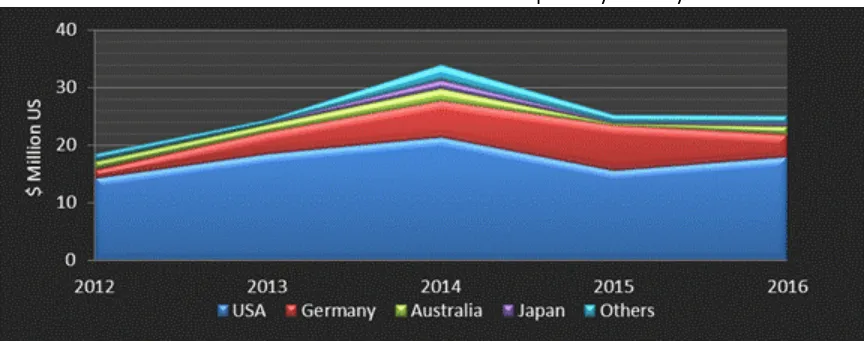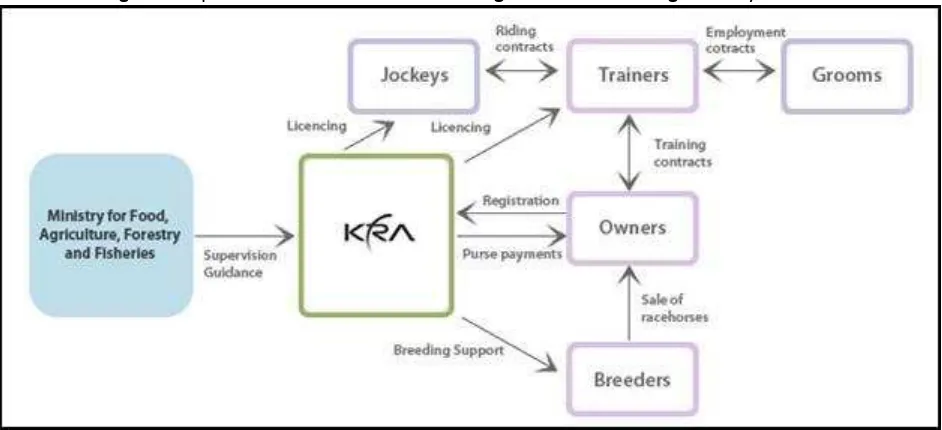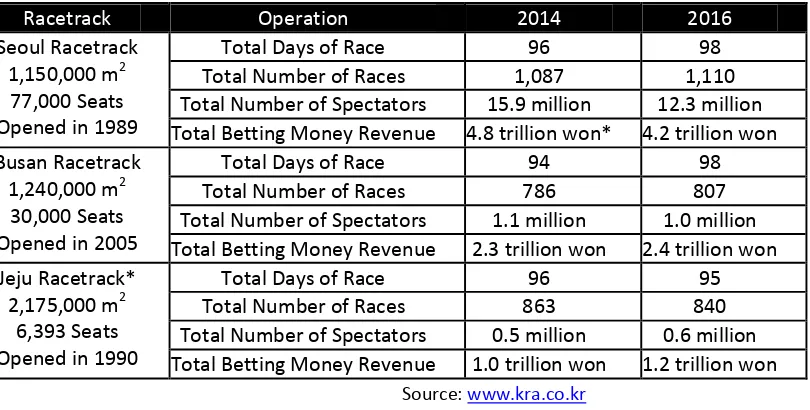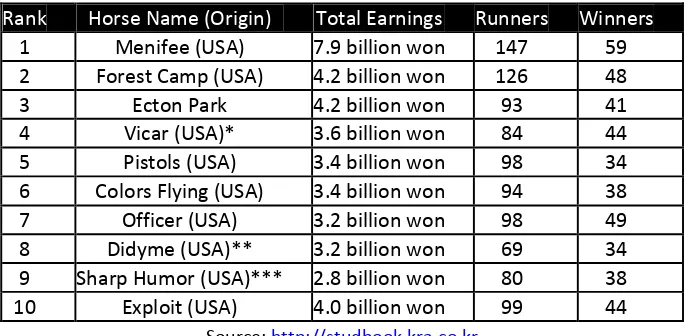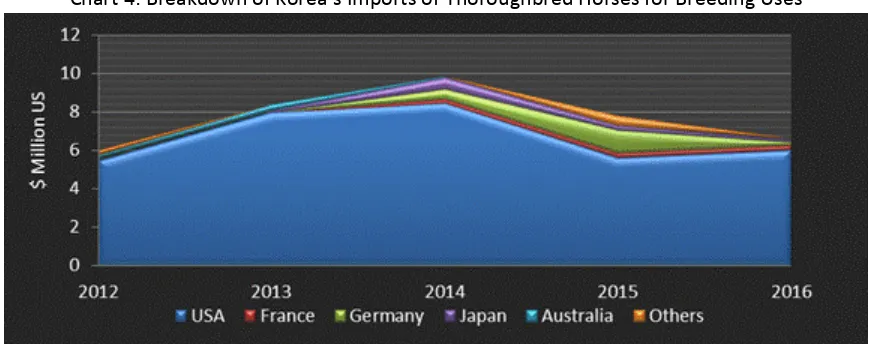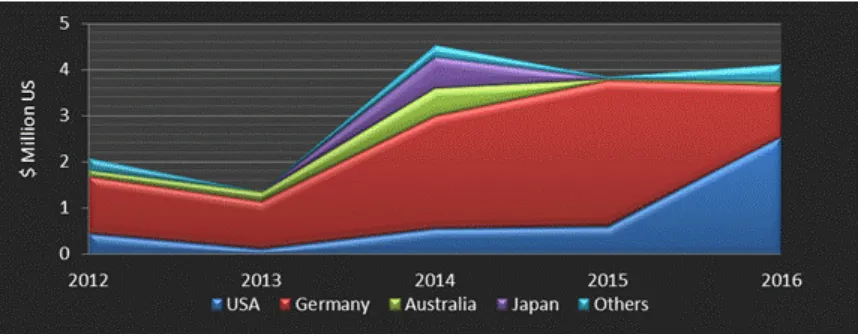THIS REPORT CONTAINS ASSESSMENTS OF COMMODITY AND TRADE ISSUES MADE BY
USDA STAFF AND NOT NECESSARILY STATEMENTS OF OFFICIAL U.S. GOVERNMENT
POLICY
-
Date:
GAIN Report Number:
Post:
Report Categories:
Approved By:
Prepared By:
Report Highlights:
“outh Ko ea s ho se i po ts totaled $ . illio i . The United States remained the leading exporter to
Korea by shipping horses valued at $18.1 million, up 15 percent from the previous year. Further development of the thoroughbred racing industry in Korea generates increased demand for quality imported genetics. In addition, the emerging recreational horseback riding industry in Korea generates new niche export
opportunities for American suppliers.
Sangyong Oh, Marketing Specialist
Lynne Larrabee, ATO Director
Livestock and Products
Horse Market Report 2017
Seoul ATO
Korea - Republic of
KS1734
2017-10-25
Public
General Information:
Table of Contents
Section I. Market Overview
Section II. Market Sector Opportunities and Challenges 1. Thoroughbred Horse Racing Industry
2. Recreational Horseback Riding Industry 3. Entry Strategy
Section III. Market Access 1. Tariffs & Taxes
2. Health Requirements for Imported Horses
Section I. Market Overview
“outh Ko ea s he ei afte efe ed to Ko ea ho se i po ts totaled $ . illio o heads i .
Thoroughbred horses for racing were the most imported horses accounting for $14.4 million (or 431 heads) of imports, followed by thoroughbred horses for breeding ($6.7 million or 154 heads) and other horses (mainly horses for dressage/recreational riding, $4.1 million or 299 heads).
The United States remained the leading supplier of the imported horse market in Korea. American horses accounted fo . pe e t of Ko ea s ho se i po ts i alue o . pe e t u e . EU countries, Australia, and Japan continued to present significant competition to American suppliers.
Chart 1: Ko ea s Ho se I po ts Value* a d Nu e
*Note: CIF value inclusive of international shipping and insurance
Source: Korean government/Korea International Trade Association (K-stat, http://stat.kita.net)
Cha t : B eakdo of Ko ea s Ho se I po ts H“K Classifi ation*
*Note: Harmonized Tariff Codes of South Korea (HSK) provides classifications for imported horses as follows. (1) Pure-bred breeding horses for farm breeding: HSK 0101211000
(2) Pure-bred breeding horses for other: HSK 0101219000 (3) Horses for racing: HSK 0101291000
(4) Other Horses: HSK 0101299000
Cha t : B eakdo of Ko ea s Ho se I po ts Cou t
The Korean horse market has long been driven by the thoroughbred horse racing industry, which is administered by the Korea Racing Authority (KRA), a quasi-government agency under the Ministry of
Agriculture, Food and Rural Affairs (MAFRA). KRA maintains a very stable business as its thoroughbred races generate about $7 billion dollars of betting revenue each year. Because of the high return on investment, KRA and the local thoroughbred horse industry have been willingly making investments to upgrade local race quality, particularly by importing quality genetics from foreign countries. In addition, KRA has implemented a series of reforms in its regulations to further develop local races and the industry. Key KRA reforms in recent years included abolishment of a ceiling purchase price set for imported horses, expansion of races that allow direct competition between locally-bred horses and imported horses, and creation of high-profile international races in Korea (the Korea Cup and the Korea Sprint). Some of these reforms were critical for Korea in getting an upgrade to Part II Group from the international thoroughbred race organization in 2016. The United States is firmly recognized among the stakeholders of the Korean thoroughbred racing industry as the leading supplier of quality genetics, including racehorses, yearlings, breeding mares, and stud stallions.
The Korean government also offers financial and regulatory support to develop the local horse industry under
the Ho se I dust De elop e t A t e a ted i . It is notable that the Korean government recognizes the
horse industry as a key source for new jobs and income for the local agricultural sector. In particular, one prong of the government plan under the Act is to foster expansion of the recreational horseback riding industry, such as trail riding and therapeutic riding. The Korean recreational horseback riding industry has long been led by dressage riding and as a result European suppliers continue to present tough competition to American suppliers for premium warmblood horses. However, emerging demand for value horses for recreational horseback riding should offer new niche export opportunities for American horses such as quarter horses and paint horses.
Table 1: Advantages & Challenges of the Korean Horse Market
Advantages Challenges
The Korean thoroughbred horse racing industry is committed to making additional investments and reforms to upgrade its race quality.
Local Korean breeders are making dedicated efforts to produce better quality horses that can compete against imported horses. As a result, the quality of locally-bred horses continues to improve.
American horses maintain a high quality reputation among Korean breeders and
racehorse owners based on outstanding results in KRA races.
The Korea-U.S. Free Trade Agreement has removed import tariffs on American horses.
It takes a high amount of resources to ship horses to Korea. Imported horses are subject to strict quarantine documentation and health inspection requirements to enter Korea.
The Korean government maintains a policy initiative to support further development of the local horse industry, including recreational horseback riding targeting the general public.
European suppliers are leading the market for premium dressage/recreational riding horses. Korean breeders and riders have yet to develop an understanding and interest in Western riding.
Section II. Market Sector Opportunities and Challenges
1. Thoroughbred Horse Racing Industry
Figure 1: Operation Structure of the Thoroughbred Horse Racing Industry in Korea
Source: Korea Racing Authority (KRA), www.kra.co.kr
The Korea Racing Authority (KRA) maintains exclusive authority to administer horse races and related industry regulations under the KRA Act implemented by the Korean government in 1962. KRA currently operates three racetracks in Korea: Seoul racetrack (located in Gwachun city), Busan racetrack (Gyeongnam province), and Jeju racetrack (an island to the south of the mainland). The Seoul and Busan racetracks are exclusively for
thoroughbred horse races. The Jeju a et a k is o l fo a es of lo al Ko ea po eed Jeju Jo-Rang-Mal and a cross breed et ee the lo al po ies a d tho ough ed ho ses Jeju Ha -Ra-Ma . A new thoroughbred racetrack was approved for construction in Youngchun city (Gyeongbuk province) in 2010 but the project has met a serious delay (the land is secured but construction has yet to start). The Youngchun racetrack (1,480,000 m2 of space) targets to accommodate a similar volume of thoroughbred horse races as the Busan racetrack. Therefore, the Youngchun racetrack is forecast to generate additional demand for about 900 racehorses upon opening.
expand consumer traffic, KRA maintains strong efforts to reach out to the general public via various social and cultural projects. In addition to betting at site, KRA now also operates mobile, on-line betting system based on real-time telecasting of its races (no other entities are allowed to administer gambling on horse races by law).
KRA thoroughbred horse races operate on a six tier system (C1 to C6) to promote quality races. Horses have to earn higher ratings to move up the tiers for bigger prize money. Additionally, top tier horses are admitted to
G a d P i a es G , G , G , a d L a d “pe ial a es. KRA has also been implementing a binary race system
in that races are separated for locally-bred horses and imported horses. However, under the initiative of promoting quality races, KRA has been expanding mixed races that are run by both local and imported horses. In particular, most of the top tier (C1 and C2) and Grand Prix races are now mixed races.
Table 2: Summary of KRA Racetrack Operation
Racetrack Operation 2014 2016
Seoul Racetrack 1,150,000 m2
77,000 Seats Opened in 1989
Total Days of Race 96 98
Total Number of Races 1,087 1,110
Total Number of Spectators 15.9 million 12.3 million Total Betting Money Revenue 4.8 trillion won* 4.2 trillion won Busan Racetrack
1,240,000 m2 30,000 Seats Opened in 2005
Total Days of Race 94 98
Total Number of Races 786 807
Total Number of Spectators 1.1 million 1.0 million Total Betting Money Revenue 2.3 trillion won 2.4 trillion won Jeju Racetrack*
2,175,000 m2 6,393 Seats Opened in 1990
Total Days of Race 96 95
Total Number of Races 863 840
Total Number of Spectators 0.5 million 0.6 million Total Betting Money Revenue 1.0 trillion won 1.2 trillion won
Source: www.kra.co.kr
*Note: $1 = 1,150 won as of October 2017
Table 3: Breakdown of Thoroughbred Horse Races in KRA Racetracks (2017)
Category Racetrack Grand
Prix/Special C1 C2 C3 C4 C5 C6
Sub-Total 43 95 148 253 459 427 474 1,899
Source: www.kra.co.kr
breeders are members of the Korea Thoroughbred Breeders Association (KTBA) located in Jeju Island, and the rest are members of the Korea Inland Breeders Association (KIBA) located in mainland Korea. Together, these local breeders raise about 3,000 young horses under training, 2,500 breeding mares, and 100 stud stallions. Some of the breeders are also registered racehorse owners.
Table 4: Number of Thoroughbred Racehorses under KRA Racetracks (2017)
Location Seoul Racetrack Busan Racetrack Total
475 Racehorse Owners 254 Racehorse Owners 729 Racehorse Owners
Origin
Locally-Horses 490 160 650 350 120 470 840 280 1,120
Total
Horses 1,100 320 1,420 700 280 980 1,800 600 2,400
The breeding farms additionally import 150 to 250 breeding mares (mostly pregnant) each year to further develop their breeds. Foals born in Korea from the imported pregnant mares are recognized as locally-bred
ho ses a d a joi K‘A s do esti ho se a es. Therefore, breeding farms prefer pregnant mares.
KRA operates stud farms in two locations (Jeju island and Jangsoo inland) and provides stud services to local breeding farms at below cost. For the stud farm program, KRA imports and maintains a herd of top quality stallions. Some of the large-scale local breeders have also established private stud service businesses either individually or as a group. American stallions have shown outstanding performance in Korea over the years as indicated by the fact that the top 10 sires of KRA races in 2016 were all American-origin stallions. K‘A s electronic Studbook (http://studbook.kra.co.kr/eng/main.jsp) provides detailed records on all thoroughbred horses in Korea dating back to 1993.
Table 5: Leading Sires of KRA Races by Purse Money Earnings (2016)
Rank Horse Name (Origin) Total Earnings Runners Winners
1 Menifee (USA) 7.9 billion won 147 59
2 Forest Camp (USA) 4.2 billion won 126 48
3 Ecton Park 4.2 billion won 93 41
4 Vicar (USA)* 3.6 billion won 84 44
5 Pistols (USA) 3.4 billion won 98 34
6 Colors Flying (USA) 3.4 billion won 94 38
7 Officer (USA) 3.2 billion won 98 49
8 Didyme (USA)** 3.2 billion won 69 34
9 Sharp Humor (USA)*** 2.8 billion won 80 38
10 Exploit (USA) 4.0 billion won 99 44
Source: http://studbook.kra.co.kr
*Note: Died in Jan. 2016 / **Note: Died in Dec. 2016 / ***Note: Died in Mar. 2015
the road (the ceiling had been increased a few times from $20,000 in 2011 to $50,000 per head until the abolition). The bilateral quarantine agreement established between Korea and the United States in 2017 allows American racehorses to travel to Korea and participate in international races organized by KRA and visa-versa. This agreement allows American suppliers to further promote the quality and value of their genetics to Korean buyers. That said, competitors, in particular Australia, EU countries, and Japan, are also targeting Korea as their top priority export market for thoroughbred genetics. Local Korean breeders have also been improving their genetics significantly over the years and are likely to present increased competition to American suppliers down the road.
Cha t : B eakdo of Ko ea s I po ts of Thoroughbred Horses for Breeding Uses
Cha t : B eakdo of Ko ea s I po ts of Tho ough ed Ho ses fo ‘a i g Uses
2. Recreational Horseback Riding Industry
According to Korean government statistics, there were 27,116 horses of all breeds raised in 1,914 breeding farms in Korea as of 2016. Thoroughbred horses accounted for 45 percent of the horses in the country while the rest were mostly native ponies or hybrid breeds. Jeju Island, which had been the center of the Korean horse industry since the 13th century for its favorable breeding climate, accounted for over 56 percent of the total horse population in Korea.
Year Number of Horse Breeding
2005 965 20,157 8,242 N/A
2007 1,291 24,669 8,062 N/A
2009 1,742 28,247 8,242 N/A
2016 1,914 27,116 12,202 706
Source: Korea Horse Industry Statistics by the Ministry of Agriculture, Food and Rural Affairs (MAFRA), http://kosis.kr
Among the breeding farms, 479 were also operating recreational horseback riding businesses, serving 47,000 regular riders in the country. Additionally, there were over 800,000 Koreans who experienced horseback riding, including 18,000 who took a therapeutic ride.
Due to an urbanized lifestyle and a metropolitan living environment, the general Korean public has limited access to recreational horseback riding. As a result, recreational horseback riding is enjoyed by a relatively small group of the Korean population today. At the same time, the recreational horseback riding industry has been mainly led and influenced by European dressage riding as an elite sport. That said, there is a newly emerging momentum in the market to further develop the recreational horseback riding industry for the general public. In particular, the Horse Industry Development Act introduced by the Korean government in 2011 has offered outstanding financial and regulatory support for local provincial governments to invest and develop needed foundations for recreational horseback riding such as construction of public riding trails and introduction of new horse breeds. For example, the Gyeongbuk provincial government has supported its horse breeders in
importing some 200 American quarter horses over the last four years to develop the genetic foundation to build a local recreational horseback riding industry.
Table 7: Policy Goals of the Korea Horse Industry Development Act
Initiative 2011 Five Year Goal
Total Number of Horses of All Breeds 30,400 50,000
Regular Equestrian Sport Riders 25,000 50,000
Number of Sport Riding Farms/Centers 300 500
People Experiencing Equestrian Activities 630,000 per year 1.5 million per year
Equestrian Professionals 250 1,100
New Jobs in Equestrian Industry N/A 10,000
Source: Ministry of Agriculture, Food and Rural Affairs (MAFRA)
EU countries have been the leading supplier of imported horses to the Korean recreational horseback riding industry over the years due to their strong heritage in dressage riding. Although the United States saw a significant growth in its shipment of horses to the Korean recreational horseback riding industry in recent years due to the American quarter horse project supported by Gyeongbuk province, EU countries are likely to present tough competition to American suppliers for premium quality horses (mostly warmbloods) needed in the Korean recreational horseback riding industry. Korean horse breeders and riders lack an understanding, experience, and skills about Western riding. The key to long-term success of American suppliers for quarter horses or other breeds in the Korean recreational horseback riding industry will be developing an understanding and interest among the local breeders and riders in Western riding.
Figure 2: Photos of American Quarter Horses Imported into Gyeongbuk Province, Korea (2016)
3. Entry Strategy
Established thoroughbred auctions in the United States are the major channel that Korean thoroughbred horse buyers use to purchase American horses. Auctions provide the buyers with an efficient venue to access a large number of candidate horses. Buyers usually attend the auction in a group together with a veterinary expert to inspect the horses on-site. Travel arrangement to auctions and bids (purchases) are normally conducted through intermediary brokers (based in Korea) who also provide the buyers with consolidated logistic services including credit finance, health inspection, documentation, insurance, air-shipping to Korea, customs clearance, and local delivery at a pre-agreed fee. On fewer occasions such as for high value stud stallions and racehorses, buyers may purchase directly from American breeding farms with the assistance of intermediary brokers.
Keeneland Sales in Kentucky (www.keeneland.com) has become the leading horse auction in the United States that draws buyers from Korea as it offers the largest number of horses of different categories for sale. Ocala Sales in Florida also remains a key auction to Korean buyers for good value racehorses and yearlings. Fasig-Tipton Sales in Maryland also draws some Korean buyers for yearlings.
Table 8: Leading American Horse Auctions for Korean Buyers
Auction Season Ko ea Bu e s Majo I te est
Keeneland Sales, Kentucky January, April, August, November
Ocala Sales, Florida April, October Racehorse, Yearling Fasig-Tipton Sales,
Maryland
May Yearling
Established intermediary brokers who maintain close contacts with key Korean buyers (racehorse owners and breeders) should be the best source for information about planned purchases and visits to upcoming American auctions of the target buyers. These brokers should also be a good source for up-to-date information on regulatory issues such as quarantine health inspection and documentation requirements of the Korean government.
Section III. Market Access
1. Tariffs and Taxes
Imported horses are currently subject to an 8 percent base import tariff calculated on the CIF (Cost, Insurance and Freight) import value. Additionally, a 10 percent value added tax (VAT) is imposed on the CIF value of imported horses.
With approval from the competent Korean government agencies, horses imported by breeding farms and equestrian sport horses for designated Korean national team members are exempted from the import tariff.
The Korea-U.S. Free Trade Agreement (KORUS FTA), implemented in 2012, has removed the 8 percent import tariff on all American horses. Both EU countries and Australia have Free Trade Agreement with Korea and their horses are also entering Korea duty free. Among major competitors, Japan has yet to establish a bilateral trade agreement with Korea to lower the import tariff.
2. Health Requirements for Imported Horses
I po ted ho ses ust eet the Ko ea go e e t s st i t ua a ti e health e ui e e ts to e te the
market. It usually takes a month for the imported horses to go through quarantine health inspections by the Korean authority upon arrival in Korea. Failure to satisfy the requirements may result in rejection or elimination of the animal at the cost of the supplier.
American horse suppliers must check the current quarantine health requirements of Korea by contacting the Animal & Plant Health Inspection Service (APHIS).
Links to APHIS Area Offices:
Section VI. Key Contacts and Further Information
(1) For information about the Korean agricultural market and regulations, please contact:
U.S. Agricultural Trade Office Seoul (ATO)
Korean Address: Room 303, Leema Building, 42 Jongro 1-gil, Jongro-gu, Seoul, Korea U.S. Mailing Address: U.S. Embassy Seoul, Unit 15550-ATO, APO, AP 96205-5550 Telephone: +82-2 6951-6848 Fax: +82-2 720-7921
E-mail: atoseoul@fas.usda.gov
Internet homepage: www.atoseoul.com
Agricultural Affairs Office, U.S. Embassy Seoul (AAO)
Korean Address: U.S. Embassy, 188 Sejong-daero, Jongro-gu, Seoul, Korea
U.S. Mailing Address: U.S. Embassy Seoul, Unit 15550-AgAff, APO, AP 96205-5550 Telephone: +82-2 397-4297 Fax: +82-2 738-7147
E-mail: agseoul@fas.usda.gov
(2) For further information about sanitary/export certificate requirements, please contact:
U.S. Animal Plant and Health Inspection Service Seoul (APHIS)
Korean Address: Room 303, Leema Building, 42 Jongro 1-gil, Jongro-gu, Seoul, Korea U.S. Mailing Address: U.S. Embassy Seoul, Unit 15550-APHIS, APO, AP 96205-5550 Telephone: +82-2 725-5495 Fax: +82-2 725-5496
E-mail: yunhee.kim@aphis.usda.gov Internet Homepage: www.aphis.usda.gov
(3) For information about export assistance programs offered by the U.S. Livestock Genetics Export, Inc., please contact:
The U.S. Livestock Genetics Export, Inc. (USLGE)
Address: 522 Springdale St., Suite 102, Mount Horeb, WI 53572 Telephone: 608-437-2020 Fax: 888-538-6596 Internet Homepage: www.uslge.org
